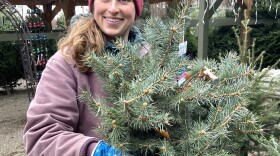Squash bugs are a garden pest that a lot of home vegetable gardeners may be struggling with right now. Homegrown NH host Emma Erler, lead horticulturalist at Kirkwood Gardens, has some techniques to fight back.
Squash bugs are fairly nondescript, with small (½ to ¾ inch) gray-brown bodies with some orange or brown barring on their abdomens.
Zucchini, summer squash and pumpkins are the biggest targets of squash bugs, although you may find them on your winter squashes as well, such as Hubbard squash or butternut squash. If you are growing melons or cucumbers, you don't have to worry about squash bugs.
They are usually present in mid- to late- June and right through summer.
”“They have piercing, sucking mouthparts they stick right into the leaves and stalks of those plants,” says Erler, “and they'll suck those plant juices out.”

They end up damaging the cells where they're doing their feeding. If the feeding is really heavy, you end up with some dead spots on the leaves, flowers, or fruits.
“The plants will actually wilt,” says Erler. “They're really a problem on plants that aren't healthy or are new in the garden, and they can die from the damage, especially if there are too many squash bugs.”
“They're kind of interesting in that they overwinter as adults, so the insect will find a spot somewhere around your garden,” says Erler.
“If you've grown squash or pumpkins before, it could be the woodpile; it could be some leaves at the edge of the woods; it could be the garden itself, where they hunker down.”
Once the temperatures warm up in the spring, they emerge to find a mate. If you have squashes or pumpkins planted in your garden, they're probably going to find a spot to lay their eggs on those plants.
Typically you're going to have issues year after year. To control them, Erler focuses on the non-chemical approach in the backyard garden, which means hand-picking or smashing them.
“Squash bug adults are really, really fast, so they can be kind of hard to catch,” she says. “But the squash bug nymphs are actually possible to catch, particularly in early mornings when the temperatures are cooler and they're moving slower. You may be able to capture them and dunk them in some soapy water.”
Erler says it’s easier to find the squash bug eggs than the insects themselves. They have small, oval, clustered eggs that are on the undersides of leaves.

“If you're in your garden scouting your squash plants, look on the underside of the leaves, Erler says. “If you see those eggs and you're not too squeamish, you can just squish them with your finger. And you've already helped get ahead of the population a bit!”
Another method of control that seems appropriate for squash bugs is to…squash them! “At night, squash bugs like to hide in the garden under leaves or other materials,” says Erler. “So if you have an old board that you can set down in your garden near your squash plants, they will go underneath that board at night. Then early in the morning, flip the board over, and you'll have a whole bunch of squash bugs that you can capture to drown in soapy water – or you can squash them!”
See you in the garden!
Homegrown NH is a collaboration between Squam Lakes Natural Science Center and NHPR.










